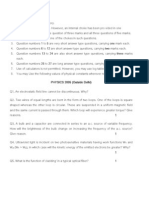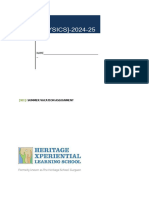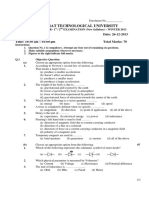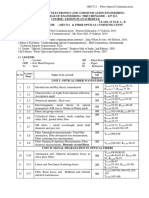0°. Determine The Spacing of The Planes.: 0°C 0°C. 0°C 0°C 0°C
Uploaded by
Rahul Kumar0°. Determine The Spacing of The Planes.: 0°C 0°C. 0°C 0°C 0°C
Uploaded by
Rahul KumarQu-1 Attempt any five of the following :
(a) Define reciprocal lattice vectors discuss their properties and physical
significance
(b) Give the properties of diamagnetic, paramagnetic and ferromagnetic
materials.
Qu-2 (a) Explain Bragg's law for X-ray diffraction. Also describe power method
of X-Ray diffraction with diagram.
(b) Electrons are accelerated to 344 volts and the reflected from a crystal, The
first reflection maximum occurs when glancing angle is 60°. Determine the
spacing of the planes.
Qu-3 (a) What is Hall effect? Discuss its significance.
(b) Obtain the Clausium - Mossotti relation between polarizability and
dielectric constant of a solid .
Qu-4 (a) What is superconductivity? Explain Meissner effect. What are Type I and Type
II superconductors?
(b) Indicate the properties of Reciprocal lattice and prove that every reciprocal
lattice is perpendicular to a direct lattice plane.
Qu-5 (a) Describe briefly the following
(i) Permeability
(ii) Relative permeability
(iii) Magnetic susceptibility
(b) Hall voltage of 0.1 mv is found to be developed when a sample carrying a
current of 10.0 mA is placed in a transverse magnetic field of of 3 hG. Calculate
the charge carriers concentration of the sample. Given the thickness of the
sample along the direction of magnetic field is 0.3 mm.
Qu-6 (a) Discuss briefly the following -
(i) Electronic polarizability
(ii) Frequency dependence of total polarizability
(b) Explain briefly
(i) Dielectric
(ii) Dielectric constant
(iii) Dielectric strength
Qu-7 (a) Debye’s Theory of specific heat of solids.
(b) A liquid takes 5 minutes to cool from 80°C to 50°C. How much time will it take
to cool from 60°C to 30°C? The temperature of the surrounding is 20°C.
You might also like
- General Instructions: Sample Question Paper Class XII - Physics (Applicable For March 2016 Examination)No ratings yetGeneral Instructions: Sample Question Paper Class XII - Physics (Applicable For March 2016 Examination)12 pages
- B.Sc. V Semester Physics:: Paper VI (A) Solid State Physics:: Imp Questions100% (1)B.Sc. V Semester Physics:: Paper VI (A) Solid State Physics:: Imp Questions2 pages
- Holiday Homework - Physics Grade XII 2024-2025No ratings yetHoliday Homework - Physics Grade XII 2024-20259 pages
- Reviews in Computational ChemistryFrom EverandReviews in Computational ChemistryAbby L. ParrillNo ratings yet
- DC Power Supplies: Technical InformationNo ratings yetDC Power Supplies: Technical Information4 pages
- B.SC (Prog) Computer Science VI Sem - AssignmentNo ratings yetB.SC (Prog) Computer Science VI Sem - Assignment3 pages
- Each Atomic Orbital Leads To A Band of Allowed States in The SolidNo ratings yetEach Atomic Orbital Leads To A Band of Allowed States in The Solid7 pages






































































